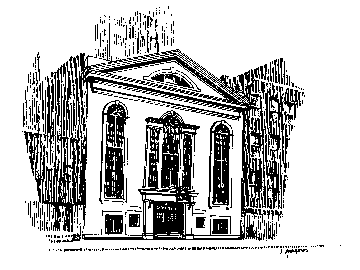The story of the John Street Church actually begins in Ireland, where Philip Embury, his wife, Barbara Ruckle Heck (Embury’s cousin), and her husband were converted to Methodism. Philip Embury became one of Wesley’s local preachers.
In 1760, a number of Irish Methodists, including the Emburys and the Hecks, immigrated to New York City. Some of the group departed from Methodist ways, to Barbara Heck’s distress. She persuaded Philip Embury to begin preaching again, and in October 1766 he began holding regular services in his home.
The services soon outgrew the Embury home, and the Methodist Society began meeting in rented facilities; first on Barrack Street and then on Horse and Cart (now William) Street. The latter was called “The Old Rigging Loft” because the upper story was sometimes used to rig ship’s sails.
Philip Embury was soon joined in the pulpit by Captain Thomas Webb, a British officer (actually with lieutenant’s rank) and a licensed Methodist lay preacher. By 1768, the congregation had outgrown the rigging loft, and on March 30, 1768, two lots on nearby John Street were purchased. The first building erected on this site was called Wesley Chapel and was dedicated on October 30, 1768. It was the first permanent home of America’s oldest continuous congegation.
A trustee, Thomas Taylor, wrote John Wesley about the chapel’s construction and requested financial help and spiritual leadership. In response, Wesley sent the first two Methodist missionaries, Joseph Pilmore and Richard Boardman, to America. They were soon followed by others, most notably Francis Asbury.
The Hecks and Emburys left New York City in 1770, but the work at John Street continued. Francis Asbury preached there numerous times, and early General Conferences held their sessions in the chapel.
A slave named Peter Williams was one of many African American members of Philip Embury’s society. He became sexton of Wesley Chapel and, with James Varick and others, formed what later became the Methodist Episcopal Zion Church.
In 1817 the chapel was torn down to make way for a larger structure, dedicated in 1818. A third (and smaller) edifice was erected in 1841 and is still in use today.
Points of interest at this Heritage Landmark: The sanctuary dates from 1841 and the interior and furnishings remain much as they were in the mid-nineteenth century.
Below the sanctuary, the Wesley Chapel Museum displays many artifacts from eighteenth and nineteenth century American Methodist history in the city of New York. These include church record books, the Wesley Clock (a gift of John Wesley, 1769), love feast cups, class meeting circular benches, the original 1785 altar rail, the original 1767 pulpit made by Philip Embury, and his owned signed Bible.
Restrooms are available at the church. Parking is prohibited on John Street on the block where the church is located. Other street parking is usually available within short walking distance, including paid lot facilities at the South Street Seaport four blocks from the church.
Special events: Concerts, services, speakers, and other special events are scheduled regularly. Contact the church for a current schedule (see address below).
Area attractions: Lower Manhattan is the oldest part of the city, and there are many historic sites in the area. Just a short walk away is South Street Seaport. The church is also close to Battery Park, where one can take a boat ride to the Statue of Liberty and Ellis Island. Another Historic Shrine, the Methodist Hospital in Brooklyn, is nearby.
To visit: John Street Church is an active United Methodist congregation and visitors are welcome for Sunday worship and weekday activities. The museum is open Monday, Wednesday, and Friday (except holidays) from noon to 5 p.m. It is open other times by appointment, and lecture tours may be scheduled by contacting the church (see address below).
Location: Within the boundaries of the New York Annual Conference, in New York County. The church is at 44 John Street, in the Wall Street section of Lower Manhattan. It is 2? blocks east of the World Trade Center site and one block south of Fulton Street.
Food and lodging: There are numerous restaurants in the area. Lodging is available in Manhattan and outside the city within commuting distance.
Directions: Subway: The closest subway stations are Broadway/Nassau (A & C lines) or Fulton Street (2,3,4,&5 lines).
Bus service: take Bus #15 to John Street or Bus #6 to Fulton Street.
Driving: from New Jersey Turnpike #95: Follow the signs to Holland Tunnel, then to Canal Street. Travel south on Broadway to John Street and turn left to #44 John Street.
For further information, contact: Pastor, John Street United Methodist Church, 44 John Street, New York NY 10038; 212-269-0014; E-mail: johnstreetumc@hotmail.com.
To learn more about United Methodist church history in this area:
Tim Riss, Archivist: C. Wesley Christman Archives, New York Annual Conference Center, 20 Soundview Avenue, White Plains, NY 10606; 914-615-2241; E-Mail: Timothy.Riss@nyac-umc.com.
Russell E. Richey, Early American Methodism (Bloomington: Indiana University Press, 1991).
The Story of Old John Street Church (New York: Raynor R. Rogers, 1984).

